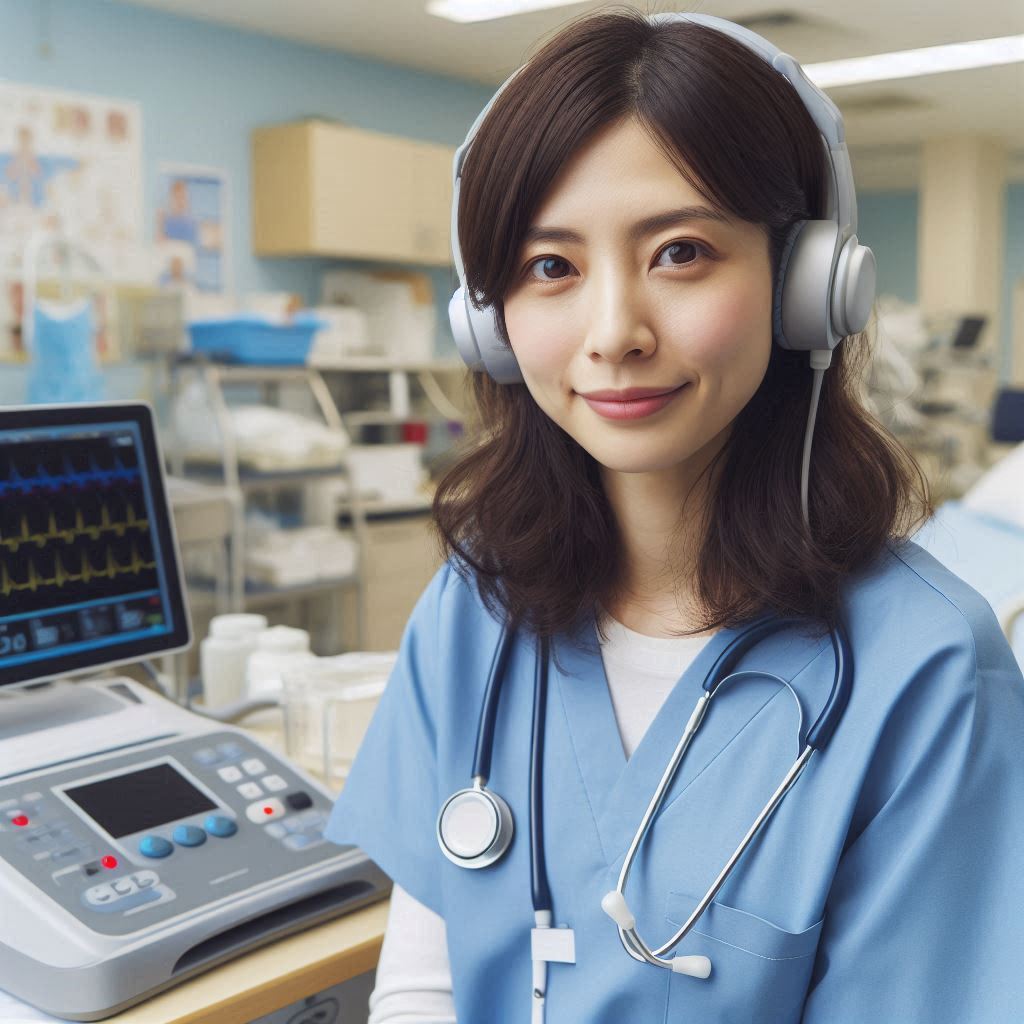Introduction
Sleep technologists play a vital role in the healthcare industry by diagnosing and treating sleep disorders.
These professionals conduct comprehensive sleep studies, analyze complex data, and collaborate closely with healthcare providers to develop effective treatment plans.
The work environment is crucial for sleep technologists, directly impacting their ability to perform their duties effectively and ensure accurate diagnoses.
A supportive and well-equipped work environment helps maintain focus, manage stress, and deliver high-quality patient care.
The significance of the work environment cannot be overstated.
It influences everything from job satisfaction and professional development to patient outcomes and safety.
Sleep technologists often work in a variety of settings, including hospitals, dedicated sleep clinics, and research facilities.
Each setting presents unique challenges and opportunities, requiring technologists to adapt and maintain high standards of practice.
Understanding these different work environments highlights the importance of creating a supportive atmosphere for these essential healthcare workers.
Hospitals provide a dynamic and fast-paced environment where sleep technologists might encounter a wide range of medical conditions and collaborate with multidisciplinary teams.
Sleep clinics, on the other hand, often offer a more focused environment dedicated to sleep studies, allowing technologists to specialize and refine their skills.
Work Setting
Sleep Labs
Sleep technologists often work in dedicated sleep labs. These labs are specifically designed for conducting sleep studies.
Sleep labs provide a controlled environment for monitoring patients overnight.
The setting allows for focused attention on sleep disorders without the distractions of a general healthcare facility.
Sleep labs typically have advanced polysomnography equipment, which sleep technologists use to collect data.
Pros
Working in a sleep lab offers a specialized environment tailored to sleep studies.
Technologists can focus exclusively on sleep disorders, leading to a deeper expertise in this area.
The controlled setting minimizes external variables, enhancing the accuracy of data collected.
Additionally, sleep labs often have a steady schedule of patients, providing consistent work hours and predictable workloads.
Cons
The specialization of sleep labs can also be limiting.
Technologists may find fewer opportunities to engage with a variety of medical conditions.
The work can become repetitive, with less variation in day-to-day tasks.
Furthermore, sleep labs often operate during nighttime hours, which can disrupt personal schedules and circadian rhythms.
Hospitals
Hospitals represent another common work setting for sleep technologists.
In hospitals, technologists might work in a dedicated sleep unit or as part of a broader respiratory therapy or neurology department.
Hospitals offer a diverse and dynamic environment, exposing technologists to a wide range of patient conditions.
Pros
Working in a hospital provides exposure to a variety of medical conditions beyond sleep disorders.
This variety can enhance a technologist’s clinical skills and knowledge.
Hospitals typically have comprehensive resources and support systems, including access to other medical specialists.
This setting fosters a collaborative approach to patient care.
Cons
The hospital environment can be hectic and stressful, with a high patient turnover and urgent care demands.
Sleep technologists may have to work irregular hours, including overnight shifts, weekends, and holidays.
The broad scope of responsibilities might also mean less focus on sleep-specific issues, potentially diluting the expertise in sleep technology.
Private Practices
Private practices offer another avenue for sleep technologists.
These practices might be part of a larger medical group or an independent clinic specializing in sleep medicine.
Private practices can provide a more intimate and personalized work environment.
Pros
Working in a private practice often means a closer, more personalized relationship with patients.
The work environment is typically less hectic than hospitals, with a more predictable schedule.
Technologists in private practices can focus deeply on sleep disorders and develop strong expertise in this niche area.
Cons
The smaller scale of private practices might limit access to advanced equipment and broader medical resources found in hospitals.
Job stability can also be a concern, as private practices might have fewer resources to weather economic fluctuations.
Additionally, opportunities for career advancement and professional development might be more limited compared to larger institutions.
Each work setting for sleep technologists offers unique advantages and challenges.
Sleep labs provide specialized focus, hospitals offer diverse experiences, and private practices deliver personalized care.
Understanding these differences helps technologists choose the environment that best aligns with their career goals and personal preferences.
Work Schedule
Sleep technologists typically work varied schedules, depending on their employment setting.
Common work schedules often include night shifts, given the nature of sleep studies.
These studies are usually conducted overnight to monitor patients’ natural sleep patterns.
Night Shifts and Long Hours
Night shifts are a standard part of a sleep technologist’s work schedule.
These shifts usually start in the evening and end early in the morning.
During this time, sleep technologists set up equipment, monitor patients throughout the night, and ensure the accuracy of data collection.
This schedule can be challenging, especially for those who are not naturally night owls.
In addition to night shifts, sleep technologists may also work long hours.
Preparing for a sleep study involves setting up complex monitoring equipment and ensuring that the patient is comfortable and ready for the study.
After the study, there is often a detailed data analysis process, which can extend the workday.
Strategies for Maintaining Work-Life Balance
Maintaining a work-life balance is crucial for sleep technologists, especially given the demands of night shifts and long hours.
One effective strategy is to establish a consistent sleep schedule, even on days off.
This helps the body adjust to the irregular hours and minimizes the impact on overall health.
Another strategy is to create a conducive sleep environment at home.
This includes making the bedroom dark, quiet, and cool, and avoiding stimulants like caffeine before bedtime.
Using blackout curtains and white noise machines can also help create an optimal sleep environment.
Prioritizing self-care is essential for maintaining work-life balance.
Sleep technologists should ensure they have time for relaxation, exercise, and hobbies.
Regular physical activity can help reduce stress and improve sleep quality.
Additionally, engaging in activities outside of work can provide a mental break and help maintain overall well-being.
Effective time management is another crucial aspect of maintaining balance.
Sleep technologists can benefit from planning their schedules in advance, setting aside time for personal activities, and avoiding overcommitting.
It‘s important to communicate with family and friends about work schedules to ensure they understand the demands and can offer support.
In the workplace, seeking support from colleagues and supervisors can also help manage the demands of the job.
Building a supportive network within the workplace can provide emotional support and practical assistance during challenging times.
Basically, the work schedule of a sleep technologist often includes night shifts and long hours, which can be demanding.
Sleep technologists can manage challenges by maintaining a consistent sleep schedule, creating a conducive environment, and prioritizing self-care.
Balancing work demands with personal well-being is crucial for a successful and fulfilling career in sleep technology.
Understanding and managing the work schedule can help sleep technologists thrive in their roles while maintaining a healthy and balanced lifestyle.
Transform Your Career Today
Unlock a personalized career strategy that drives real results. Get tailored advice and a roadmap designed just for you.
Start NowTeam Dynamics
Importance of Teamwork in Sleep Technology
Teamwork is crucial in the field of sleep technology.
Sleep technologists often work alongside a team of healthcare professionals to ensure accurate diagnoses and effective treatments.
Collaborative efforts enhance the quality of patient care and streamline the process of conducting sleep studies.
Collaborative Nature of Working with Healthcare Professionals
Sleep technologists collaborate closely with doctors, nurses, and other specialists.
This collaboration is essential for developing comprehensive treatment plans for patients with sleep disorders.
Technologists provide detailed data and observations, which are critical for physicians to make informed decisions.
Effective teamwork requires clear communication and mutual respect.
Each team member’s role is important, and understanding these roles helps to create a cohesive and efficient work environment.
By working together, healthcare professionals can provide the best possible care for patients.
Tips for Effective Communication and Teamwork
Effective communication is the foundation of successful teamwork.
Sleep technologists should practice active listening, ensuring they fully understand instructions and feedback from colleagues.
Clear and concise communication helps prevent misunderstandings and ensures that everyone is on the same page.
Regular team meetings can foster better communication and collaboration.
These meetings provide opportunities to discuss patient cases, share insights, and address any issues that may arise.
Open dialogue during meetings encourages team members to contribute their perspectives and expertise.
Another tip for effective teamwork is to build strong relationships with colleagues.
Taking the time to get to know team members and understand their working styles can improve collaboration.
Trust and respect are built over time, leading to a more supportive and productive team environment.
Conflict resolution skills are also essential for maintaining a positive team dynamic.
Sleep technologists should address conflicts promptly and constructively, focusing on finding solutions rather than placing blame.
Effective conflict resolution fosters a harmonious work environment and strengthens team cohesion.
Flexibility and adaptability are important traits for effective teamwork.
Sleep technologists should be willing to adjust their schedules and tasks to meet the needs of the team and patients.
This flexibility demonstrates a commitment to the team’s goals and enhances overall efficiency.
Recognizing and appreciating the contributions of team members is also vital.
Positive reinforcement and acknowledgment of hard work can boost morale and motivate the team.
Celebrating successes, both big and small, fosters a positive work culture and strengthens team bonds.
Read: The Role of Technology in Modern Sonography
Equipment and Technology
Sleep technologists utilize a variety of equipment and technology to monitor and assess patients during sleep studies.
These tools are essential for accurately diagnosing sleep disorders and providing effective treatment plans.
Equipment and technology used by sleep technologists
- Polysomnography machines: These devices track brain waves, heart rate, breathing patterns, and other physiological markers during sleep.
- Oxygen monitors: Used to measure oxygen levels in the blood, which can indicate issues like sleep apnea.
- Actigraphy devices: Worn on the wrist to track movement and rest patterns over an extended period.
- CPAP machines: Continuous Positive Airway Pressure machines are used to treat sleep apnea by keeping airways open.
- EEG machines: Electroencephalography machines record brain wave activity while patients sleep.
How to properly operate and maintain the equipment
Proper operation and maintenance of sleep technology equipment are crucial to ensure accurate results and patient safety.
- Regular calibration: Equipment should be calibrated regularly to ensure accurate readings.
- Cleaning and sanitizing: Follow manufacturer guidelines for cleaning and sanitizing equipment to prevent contamination.
- Storage: Store equipment properly in a clean, dry, and secure location when not in use.
- Training: Technologists should undergo training on how to operate and maintain each piece of equipment.
- Repairs and servicing: Promptly address any issues with equipment to prevent disruptions in patient care.
Impact of technological advancements on the field
Advancements in technology have revolutionized the field of sleep medicine, making diagnosis and treatment more efficient and effective.
- Improved accuracy: New technologies provide more precise data, leading to better diagnosis and treatment plans.
- Enhanced patient comfort: Modern equipment is designed to be more comfortable for patients, improving overall experience.
- Remote monitoring: Technological advancements allow for remote monitoring of patients, increasing accessibility to care.
- Data analysis: Advanced software can analyze sleep data more efficiently, helping technologists interpret results quickly.
- Personalized treatment: Technology enables personalized treatment plans tailored to each patient’s specific needs and condition.
Read: Surgical Technologist Job Outlook: Demand and Opportunities
Physical Environment
Physical Demands of the Job
Sleep technologists often face physical demands in their work environment.
They frequently stand for long periods, especially during patient monitoring.
Setting up and adjusting monitoring equipment also requires a fair amount of physical activity.
Additionally, sleep technologists might need to assist patients with mobility issues, which can involve lifting or repositioning them.
This physical aspect of the job necessitates good physical health and stamina.
Tips for Staying Comfortable and Preventing Burnout
To stay comfortable and prevent burnout, sleep technologists should prioritize their well-being. One key tip is to wear supportive footwear.
Comfortable shoes with good arch support can reduce fatigue and prevent foot pain during long shifts.
Taking short breaks to stretch and move around can also help alleviate discomfort from standing for extended periods.
Maintaining a healthy lifestyle is crucial for preventing burnout. Regular exercise can improve physical endurance and reduce stress levels.
A balanced diet and adequate hydration also support overall health and energy levels.
Sleep technologists should ensure they get sufficient rest, especially given the irregular hours they may work.
Practicing mindfulness and relaxation techniques can help manage stress and prevent burnout.
Techniques such as deep breathing, meditation, or yoga can promote relaxation and mental well-being.
It’s essential for sleep technologists to find time for activities they enjoy outside of work to maintain a healthy work-life balance.
Importance of Ergonomics in the Work Environment
Ergonomics plays a vital role in creating a safe and comfortable work environment for sleep technologists.
Proper ergonomic practices can prevent musculoskeletal disorders and enhance overall comfort.
Setting up workstations to support good posture is crucial. This includes adjustable chairs and work surfaces that promote a neutral body position.
When working with monitoring equipment, sleep technologists should ensure that screens and controls are at eye level to avoid neck strain.
Using ergonomic tools, such as keyboard trays and mouse pads with wrist supports, can also reduce the risk of repetitive strain injuries.
Transform Your Career Today
Unlock a personalized career strategy that drives real results. Get tailored advice and a roadmap designed just for you.
Start NowIn patient care areas, having adjustable beds and equipment can ease the physical demands of lifting and repositioning patients.
Training on proper body mechanics and lifting techniques is essential to prevent injuries.
Using lifting aids, such as transfer belts or mechanical lifts, can reduce the physical strain on sleep technologists.
Basically, the physical environment of sleep technologists involves various demands, such as standing for long periods and lifting patients.
To stay comfortable and prevent burnout, it is essential to wear supportive footwear, take regular breaks, maintain a healthy lifestyle, and practice relaxation techniques.
Ergonomics play a crucial role in creating a safe and comfortable work environment.
Proper workstation setup, ergonomic tools, and training on body mechanics can significantly reduce physical strain and enhance overall comfort.
By prioritizing their well-being and incorporating ergonomic practices, sleep technologists can thrive in their roles while maintaining good physical health.
Understanding and addressing the physical demands of the job is key to a successful and fulfilling career in sleep technology.
Read: Interview Tips for Landing a Surgical Technologist Job

Uncover the Details: Client Success Stories in Rehabilitation Counseling
Patient Interaction
Importance of Building Rapport with Patients
Building rapport with patients is vital for sleep technologists. Establishing trust and comfort is key to a successful sleep study.
Patients are more likely to cooperate and relax when they feel understood and respected.
A strong rapport can lead to more accurate data, as patients are more likely to follow instructions and remain calm during the study.
Challenges of Working with Sleep-Deprived or Anxious Patients
Sleep technologists often work with sleep-deprived or anxious patients, which presents unique challenges.
Sleep-deprived patients can be irritable or uncooperative, making the process more difficult.
Anxiety can further complicate the situation, causing patients to struggle with falling or staying asleep during the study.
These challenges require patience, empathy, and effective communication from sleep technologists.
Sleep deprivation can also affect a patient’s ability to understand and follow instructions.
Technologists must be prepared to repeat information and provide additional support as needed.
Anxiety can manifest in various ways, including restlessness, difficulty concentrating, and heightened sensitivity to their surroundings.
These factors can interfere with the sleep study and require careful management.
Strategies for Effectively Communicating with Patients
Effective communication is crucial in managing patient interactions.
Sleep technologists should use clear and simple language to explain procedures and address concerns.
Taking the time to listen to patients’ fears and anxieties can help technologists provide appropriate reassurance and support.
Begin with a Warm Greeting
Starting with a warm and friendly greeting sets a positive tone and helps patients feel more comfortable.
Technologists should introduce themselves and explain their role in the sleep study process.
This initial interaction is an opportunity to build trust and establish rapport.
Provide Detailed Explanations
Patients are often anxious about what to expect during a sleep study.
Providing detailed explanations of the equipment, procedures, and the study’s purpose can alleviate anxiety.
Technologists should ensure patients understand each step and feel comfortable asking questions.
Use Non-Verbal Communication
Non-verbal communication is as important as verbal communication.
Body language, facial expressions, and tone of voice can convey empathy and understanding.
Maintaining eye contact and using a calm, soothing voice can help reassure patients.
Address Concerns Promptly
Addressing patient concerns promptly and respectfully is crucial.
If a patient expresses discomfort or fear, technologists should take the time to address these issues thoroughly.
This might involve adjusting equipment, explaining procedures again, or simply offering words of comfort.
Create a Relaxing Environment
Creating a relaxing environment is another effective strategy.
Ensuring the sleep study room is comfortable, quiet, and free from distractions can help patients relax.
Small touches, such as providing a comfortable pillow or blanket, can make a significant difference.
Show Genuine Interest
Building rapport also involves showing genuine interest in the patient’s well-being.
Asking about their day, their experiences with sleep, and any concerns they may have can help build a connection.
This rapport can lead to better cooperation and more accurate study results.
Use Relaxation Techniques
Incorporating relaxation techniques can help anxious patients.
Guided breathing exercises, gentle music, or calming visuals can create a soothing atmosphere.
Technologists can guide patients through these techniques to help them relax before the study begins.
In review, patient interaction is a critical aspect of the work environment for sleep technologists.
Building rapport with patients fosters trust and comfort, leading to more successful sleep studies.
Sleep-deprived or anxious patients present unique challenges, but effective communication strategies can help manage these issues.
Technologists should use clear language, provide detailed explanations, and address concerns promptly to ensure positive patient interactions.
Creating a relaxing environment and showing genuine interest in patients’ well-being can further enhance rapport.
By prioritizing effective patient interaction, sleep technologists can improve study outcomes and contribute to better patient care.
Understanding and implementing these strategies is crucial for success in the field of sleep technology.
Read: Continuing Education for Surgical Technologists: Why It Matters
You Might Also Like: Importance of Substance Abuse Counselors in Healthcare
Emotional Support
Addressing the Emotional Toll of Working with Patients
Working with patients who have sleep disorders can take an emotional toll on sleep technologists.
They often witness patients struggle with chronic issues, such as insomnia and sleep apnea.
Seeing patients experience frustration, anxiety, and other sleep-related problems can be emotionally draining.
Sleep technologists must remain empathetic and supportive, which requires emotional resilience.
Understanding the emotional impact of this work is crucial for maintaining mental health.
Strategies for Self-Care
Self-care is essential for sleep technologists to manage the emotional demands of their job.
One effective strategy is to establish a routine that includes regular exercise, a balanced diet, and adequate sleep.
Physical well-being supports emotional resilience, making it easier to handle work-related stress.
Engaging in hobbies and activities outside of work provides a necessary mental break.
Activities like reading, gardening, or practicing a musical instrument can offer relaxation and enjoyment, helping to recharge emotionally.
Transform Your Career Today
Unlock a personalized career strategy that drives real results. Get tailored advice and a roadmap designed just for you.
Start NowAnother important aspect of self-care is setting boundaries between work and personal life.
Sleep technologists should avoid bringing work-related stress home.
Establishing clear boundaries can prevent burnout and ensure a healthy work-life balance.
Taking regular breaks during shifts is also essential. Short breaks can provide time to decompress, clear the mind, and return to work with renewed focus.
Seeking Support from Colleagues
Colleagues can be a valuable source of emotional support.
Sharing experiences and discussing challenges with fellow sleep technologists can alleviate feelings of isolation.
Colleagues can offer practical advice, share coping strategies, and provide a listening ear.
Building a supportive network within the workplace fosters a sense of camaraderie and mutual understanding.
Team meetings and informal gatherings can strengthen these bonds, creating a more cohesive and supportive work environment.
Participating in professional development opportunities and support groups can also be beneficial.
These platforms provide a space to learn from others’ experiences, gain new perspectives, and develop coping strategies.
Seeking mentorship from more experienced colleagues can provide guidance and support.
Mentors can offer insights based on their own experiences, helping less experienced technologists navigate the emotional aspects of the job.
Importance of Mental Health Resources
Access to mental health resources is vital for sleep technologists.
Employers should provide resources such as counseling services, stress management programs, and mental health workshops.
These resources can offer professional support and guidance, helping technologists manage emotional stress effectively.
Encouraging the use of these resources can foster a culture of openness and support within the workplace.
Employers should also promote mental health awareness and create an environment where seeking help is encouraged.
Providing regular training on stress management and mental health can equip employees with tools to cope with emotional challenges.
Recognizing the signs of burnout and offering early intervention can prevent more serious mental health issues.
Generally, emotional support is crucial in the work environment of sleep technologists.
Addressing the emotional toll of working with patients who have sleep disorders is essential for maintaining mental health.
Strategies for self-care, such as regular exercise, setting boundaries, and engaging in hobbies, can help manage stress.
Seeking support from colleagues and participating in professional development opportunities can provide additional emotional resilience.
Access to mental health resources, such as counseling services and stress management programs, is vital for sleep technologists.
Employers should promote mental health awareness and create a supportive environment where seeking help is encouraged.
By prioritizing emotional support, sleep technologists can maintain their well-being and continue to provide high-quality care to their patients.
Conclusion
In summary, sleep technologists operate in diverse environments, ranging from hospitals and specialized sleep clinics to research facilities.
They utilize advanced equipment to monitor and analyze sleep patterns, providing crucial data for diagnosing and treating sleep disorders.
The work environment significantly influences their ability to perform these tasks effectively.
A supportive work environment is crucial for the success and well-being of sleep technologists.
It enhances job satisfaction and overall performance, enabling them to deliver high-quality patient care.
Such an environment fosters professional growth, encourages continuous learning, and provides the necessary resources to excel in their roles.
When considering a career in sleep technology, it is essential to evaluate the work environment carefully.
Factors such as the availability of advanced technology, the support of a collaborative team, and opportunities for professional development can significantly impact your career satisfaction and growth.
A conducive work setting not only fosters better patient care but also enhances job fulfillment.
Sleep technologists who work in supportive environments are more likely to experience higher levels of job satisfaction and reduced stress, contributing to a healthier work-life balance.




